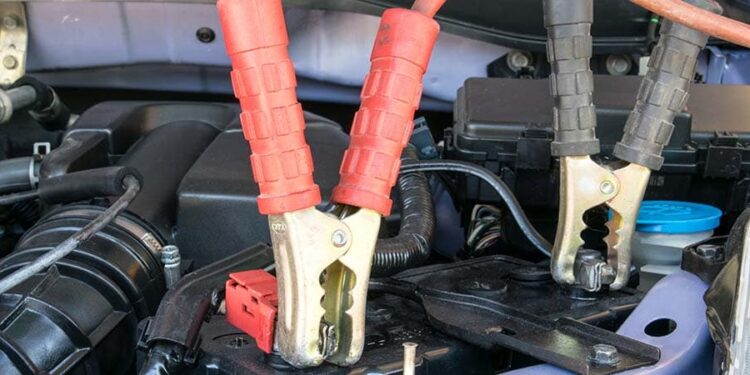You really don’t want to have your car’s battery die on you at any point. More so when it’s raining! So, can you jump a car when it’s raining? More importantly, should you try to jump-start your car in the rain? Let’s discuss this and a lot more in our article on jumping a car safely in the rain.
Getting caught in a heavy downpour and having to wait it out on the side of the road is every driver’s worst nightmare. It’s not hard to jump-start a dead battery when it’s dry out, but is it safe to do so when it’s pouring outside? It’s a totally valid fear. After all, we’ve all been taught that water and electricity don’t get along very well.
The hoary old chestnut that you shouldn’t try to jump-start your car when it’s raining has been around for decades. So there’s no better time than now to find out the facts.
So can you really jump-start a car in the rain?
In most cases, you can jump-start a car in the rain as long as your jumper cables are in good condition.
So first off, ensure your cables are in good working condition and the insulation is not damaged. This is crucial because water seeping into the electrical system via damaged cables might cause a short circuit.
Next, take all necessary safety measures to eliminate or limit the potentially catastrophic outcomes if something goes wrong.
Put on some gloves, so you don’t touch any electrical components. Also, make sure you don’t contact both battery terminals at once and that you connect the cables in the right order.
While no immediate risk is involved with jump-starting a car in the rain, doing so can expose the battery to water. This can lead to corrosion and shorten the battery’s lifespan. Also, avoid jump-starting batteries if they are frozen or leaking. Doing so could cause an explosion.
Can you get electrocuted by jumping a car in the rain?
It’s no more dangerous to jump-start a car when it’s raining than when it’s dry. This is because a car’s battery runs on 12 volts, which is too low to cause death by electrocution.
There are, of course, some risks to be aware of whenever you jump-start a car. For example, Short-circuiting is a possible problem, and you could get burned by the battery.
Can you jump your car in when there’s lightning?
Following the abovementioned precautions, you can safely jump-start your car during a thunderstorm. But just being outside during a lightning storm is dangerous in and of itself.
You know the drill. You must not stand in the middle of a field or under a tree. Because of these other risks, we really think that you should just wait it out. Most storms are over in about 30 minutes. So just wait until the worst of the storm is over, and then try to start your car with a jump. After that, you will be drier, and the chances of getting struck by lightning have gone down.
Is it safe to jump-start a wet car battery?
Yes, it is safe. However, you must drain any extra water from the battery before connecting the jumper cables. Also, when attempting to jump the battery, keep it as dry as possible. While you are at minimal risk, delicate electronics in the engine area still don’t play well with water. If you have an umbrella, use it.
How to jump a car safely in the rain
Jump-starting your car while it’s raining is quite simple as long as you follow these basic measures to avoid any risks.
1. Get the vehicle ready
The first step is to study your car manual before connecting any leads to a battery. This is because each automobile type may have a somewhat different sequence of actions to jump-start the vehicle. Remember to switch off everything that requires power, including lights, air conditioning, and radio, because you want as much electricity as possible going straight to the battery.
2. Connect jumper cables
The next step is to locate the two red and black jumper cords. Ensure no other electrical components are in the way before connecting any cords to the battery. The red cable connects the positive terminals of both batteries.
Attach one red clamp to the red battery terminal of the donor vehicle, then do the same to the other vehicle with the other red clamp. Next, connect one black clamp to the black terminal of the donor car’s functional battery using the black cable. Finally, attach the other end to a metal surface on the car with the dead battery, such as the engine block.
3. Start the car that’s doing the jumping
Now you want to start the automobile with a decent battery and let it run for a few minutes. This restores some power to your dead battery.
4. Start the car that needs to be jumped
After a few minutes, you can try to start your vehicle using your previously powerless battery, which should now have some power. If everything goes according to plan, the car should start. If your car does not start, you may need to wait a little longer before attempting again.
5. Disconnect the cables
The last step is to take the jumper cables off of your car in the right order. To safely remove the cables, you should remove the clamps in the opposite order. This means that you have to unplug the black cable before you can unplug the red cable. Make sure you keep the clamps connecting to the batteries away from any metal objects.
Precautions to take
Drivers should be aware of the following when attempting to start their vehicle in the rain:
Prevent water from falling on the battery connections.
Before attempting to jump-start, be sure the battery is not frozen.
Connecting automobiles with incompatible batteries, such as 6-volt and 12-volt batteries
Red is positive, whereas black is negative.
Make secure connections.
The red terminal clamp must be attached first, followed by the black clip.
In any event, do not allow the two wires to come into contact with one other. Disconnect them carefully.
When car-jumping on your own, always remember to use safety gear. It’s important to remember that jumping a car isn’t without its dangers, so a roadside assistance company would gladly do it for you if you’re worried about it.
Source: Way
Do you have a story in your community or an opinion to share with us: Email us at editorial@watchdoguganda.com












